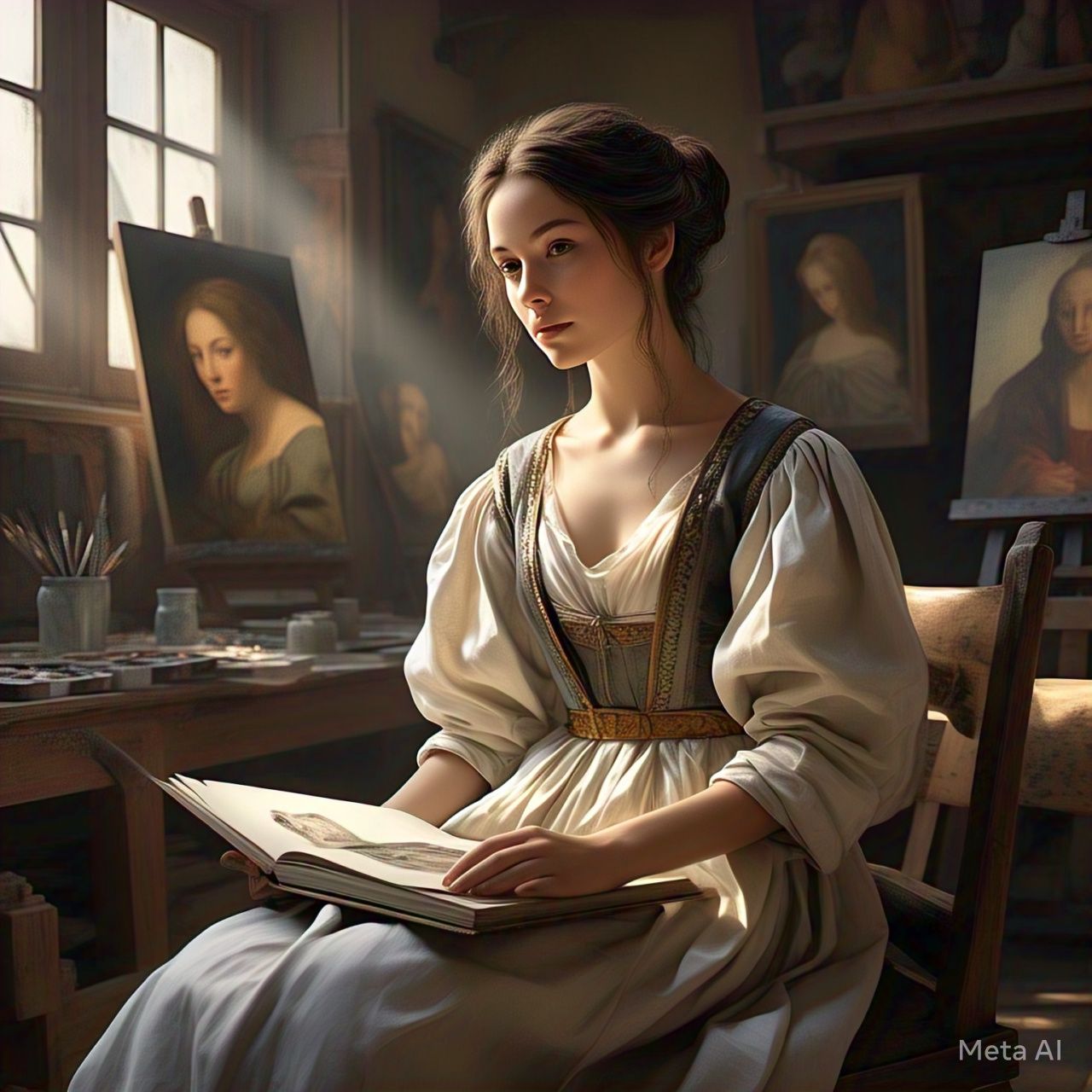Early Depictions in Ancient Art
The Significance of Hair and Eye Color in Art
Throughout history, artists have used physical traits such as hair and eye color to convey meaning, symbolism, and cultural ideals. Brown hair and green eyes, though not the most common combination, have held a unique place in artistic representations. These features often symbolize natural beauty, mystery, and even supernatural qualities depending on the era and culture. This article explores how brown hair and green eyes have been portrayed in art, from ancient civilizations to modern times, and what these depictions reveal about societal values.
Brown Hair and Green Eyes in Ancient Civilizations
In ancient art, depictions of hair and eye color were not always precise due to limited pigments and stylistic conventions. However, some cultures placed importance on these traits.
In Egyptian art, for example, gods and goddesses were often shown with dark hair, which symbolized fertility and strength. While green eyes were rare in Egyptian depictions, the color green itself was sacred, representing rebirth and protection. The god Osiris, associated with the afterlife, was sometimes portrayed with green skin, suggesting a possible link between green hues and divinity.
Greek and Roman art also featured figures with brown hair, particularly in sculptures and pottery. Goddesses like Demeter, linked to agriculture and the earth, were often depicted with rich brown locks, reinforcing their connection to nature. Green eyes, though less common in surviving artworks, appeared in descriptions of mythical beings. For instance, poets described nymphs and sea deities as having striking green eyes, associating them with enchantment and the natural world.
Symbolism in Early Religious Art
As art evolved into the medieval period, religious themes dominated, and hair and eye color took on symbolic meanings. Brown hair was frequently seen in depictions of saints and biblical figures, representing humility and earthly connection. Meanwhile, green eyes were occasionally used in portrayals of mystical or otherworldly figures, such as angels or demons, emphasizing their supernatural nature.
In Byzantine mosaics, saints often had dark, stylized hair, while their eyes were large and expressive, though not always colored realistically. The use of gold and vibrant hues in these works meant that eye color was sometimes more symbolic than lifelike. Green, when used, could suggest wisdom or divine insight.
Cultural Variations in Early Art
Different cultures interpreted brown hair and green eyes in distinct ways. In Asian art, for example, dark hair was the norm, but green eyes were almost never depicted unless the subject was a foreigner or mythical creature. Meanwhile, in Celtic and Norse traditions, green eyes were sometimes linked to magical beings like fairies or seers, while brown hair represented strength and resilience.
This early period set the foundation for how these traits would be portrayed in later centuries, with artists continuing to use them as tools for storytelling and symbolism.
Renaissance and Baroque Interpretations
The Rise of Realism in Portraiture
The Renaissance marked a shift toward realism in art, with painters paying closer attention to human anatomy and natural features. Brown hair and green eyes became more accurately depicted, reflecting the growing interest in individuality and human beauty.
Artists like Leonardo da Vinci and Raphael painted subjects with rich brown hair, using subtle shading to create depth and texture. Green eyes, though still uncommon, appeared in portraits of noblewomen and mythological scenes, often enhancing the subject’s allure.
Mythological and Biblical Themes
In Renaissance art, mythological figures were frequently given striking features to emphasize their otherworldly nature. Venus, the goddess of love, was sometimes portrayed with auburn or dark brown hair and captivating green eyes, symbolizing beauty and desire. Similarly, biblical heroines like Judith were depicted with dark hair and intense gaze, reinforcing their strength and determination.
The Baroque period further dramatized these traits. Artists like Caravaggio used chiaroscuro (strong contrasts between light and dark) to highlight facial features, making brown hair appear lustrous and green eyes more piercing. This technique added emotional intensity to paintings, drawing viewers into the narrative.
Social Status and Fashion Influences
During these periods, hair color and eye color were also influenced by fashion and social status. Noblewomen often dyed their hair darker shades to emulate classical beauty ideals, while green eyes were considered exotic and enchanting. Portraits of royalty and wealthy patrons frequently emphasized these traits to convey elegance and refinement.
Symbolic Meanings in Still Life and Allegory
Beyond portraiture, brown hair and green eyes appeared in allegorical works. For example, a woman with green eyes might represent nature or envy, depending on the context. Brown hair, often seen in depictions of peasants, could symbolize simplicity and hard work, while in aristocratic portraits, it suggested sophistication.
The Renaissance and Baroque periods solidified the artistic importance of these features, blending realism with deeper symbolic meanings.
Romanticism to Impressionism – The Evolution of Beauty Ideals
The Romantic Era: Emotion and Natural Beauty
The Romantic period (late 18th to mid-19th century) brought a shift toward emotion, individualism, and a deep appreciation for nature. Artists began portraying brown hair and green eyes in ways that emphasized passion, mystery, and the sublime.
Painters like Eugène Delacroix and Francisco Goya used rich, dark tones to depict flowing brown hair, often wild and untamed, symbolizing freedom and raw emotion. Green eyes, though still rare, appeared in portraits of enigmatic figures—lovers, rebels, and tragic heroines—enhancing their allure and depth.
In literary-inspired paintings, such as depictions of Shakespeare’s Ophelia or Goethe’s heroines, brown hair and green eyes were used to convey melancholy and poetic beauty. The contrast between dark hair and vivid green eyes created a striking visual effect, drawing viewers into the emotional intensity of the scene.
Pre-Raphaelite Brotherhood: A Return to Medieval and Mythological Aesthetics
The Pre-Raphaelite movement (mid-19th century) rejected industrial-era realism in favor of medieval and Renaissance-inspired romanticism. Artists like Dante Gabriel Rossetti and John Everett Millais frequently painted women with lush brown hair and piercing green eyes, embodying an idealized, almost otherworldly beauty.
These features were not just aesthetic choices but carried symbolic weight:
- Brown hair represented natural purity and connection to the earth.
- Green eyes suggested enchantment, wisdom, or even supernatural origins.
Famous works like “Ophelia” (Millais) and “Proserpine” (Rossetti) showcased pale, ethereal women with flowing brown locks and mesmerizing green eyes, reinforcing the Pre-Raphaelite fascination with tragic and mystical femininity.
Impressionism: A Shift Toward Light and Realism
By the late 19th century, Impressionism emerged, focusing on light, movement, and everyday life rather than idealized beauty. While many Impressionists preferred capturing fleeting moments over detailed portraiture, some still highlighted distinctive features like brown hair and green eyes in their work.
Pierre-Auguste Renoir and Édouard Manet painted women with soft brown hair in natural settings, using loose brushstrokes to suggest texture rather than precise detail. Green eyes, when present, were rendered with subtle hints of color, blending into the play of light rather than standing out dramatically.
This period marked a departure from the intense symbolism of earlier eras, instead favoring a more relaxed, realistic approach to human features.
Cultural and Social Influences on Beauty Standards
The 19th century saw changing attitudes toward beauty, influenced by literature, fashion, and emerging scientific theories.
- Victorian England associated brown hair with modesty and virtue, while green eyes were sometimes linked to deceit or seduction in literature (e.g., femme fatales in Gothic novels).
- French Bohemian culture celebrated unconventional beauty, with artists and writers romanticizing women who had striking green eyes and dark hair as muses of creativity.
These shifting perceptions ensured that brown hair and green eyes remained significant in art, whether as symbols of purity, danger, or artistic inspiration.
Modern and Contemporary Art – Reinventing Tradition
The Birth of Modernism: Breaking Conventions
The early 20th century saw a dramatic shift in artistic styles, with Modernism challenging traditional representations of beauty. Artists like Gustav Klimt and Amedeo Modigliani reimagined human features, including brown hair and green eyes, through abstract and stylized forms.
- Klimt’s golden portraits often depicted women with flowing brown hair, intertwined with decorative patterns that symbolized both sensuality and intellectual depth.
- Modigliani’s elongated figures featured almond-shaped green eyes, conveying mystery and melancholy in a way that defied realism.
These artists moved away from literal depictions, instead using color and form to evoke emotion. Brown hair was no longer just a natural trait but a compositional element, while green eyes became symbols of introspection and modernity.
Surrealism and the Subconscious
The Surrealist movement (1920s–1950s) took interpretations of physical features into the realm of dreams and the unconscious. Artists like Salvador Dalí and René Magritte distorted human forms, making brown hair and green eyes part of fantastical, symbolic landscapes.
- In Dalí’s “The Persistence of Memory,” though not a portrait, the surreal melting forms suggest a fluidity of identity where traditional features dissolve.
- Magritte’s “The Son of Man” obscures the face but plays with the idea of hidden identity—green eyes, if visible, might have added to the enigmatic quality.
Surrealism’s focus on the irrational meant that even common traits like brown hair and green eyes could be reimagined as elements of psychological intrigue.
Pop Art and Commercialization of Beauty
By the mid-20th century, Pop Art transformed how physical traits were portrayed, blending high art with mass media. Artists like Andy Warhol and Roy Lichtenstein used bold, graphic styles to critique celebrity culture and beauty standards.
- Warhol’s screen prints of icons like Jackie Kennedy and Elizabeth Taylor highlighted their dark hair and striking eyes, but in a detached, repetitive manner that questioned authenticity.
- Lichtenstein’s comic-inspired women often had stylized brown hair and bright green eyes, reducing them to exaggerated symbols of femininity.
In this era, brown hair and green eyes became less about natural beauty and more about constructed identity, shaped by advertising and popular culture.
Contemporary Art: Diversity and Reinterpretation
Today, contemporary artists explore brown hair and green eyes through lenses of identity, race, and technology.
- Kehinde Wiley’s portraits reimagine classical poses with modern subjects, often celebrating natural features like brown hair in the context of Black identity.
- Digital artists manipulate eye color to surreal extremes, using green eyes as a focal point in futuristic or fantastical characters.
The once-rigid symbolism of these traits has dissolved, replaced by individual expression and cultural commentary.
Conclusion: An Enduring Legacy
From ancient goddesses to digital avatars, brown hair and green eyes have held a fascinating role in art. They have symbolized earthiness and mystery, virtue and danger, realism and fantasy. As artistic movements evolved, so did their interpretations—reflecting changing ideals of beauty, power, and identity.
Today, these features are no longer bound by tradition but continue to inspire, proving that even the simplest physical traits can carry profound meaning across centuries of creativity.










